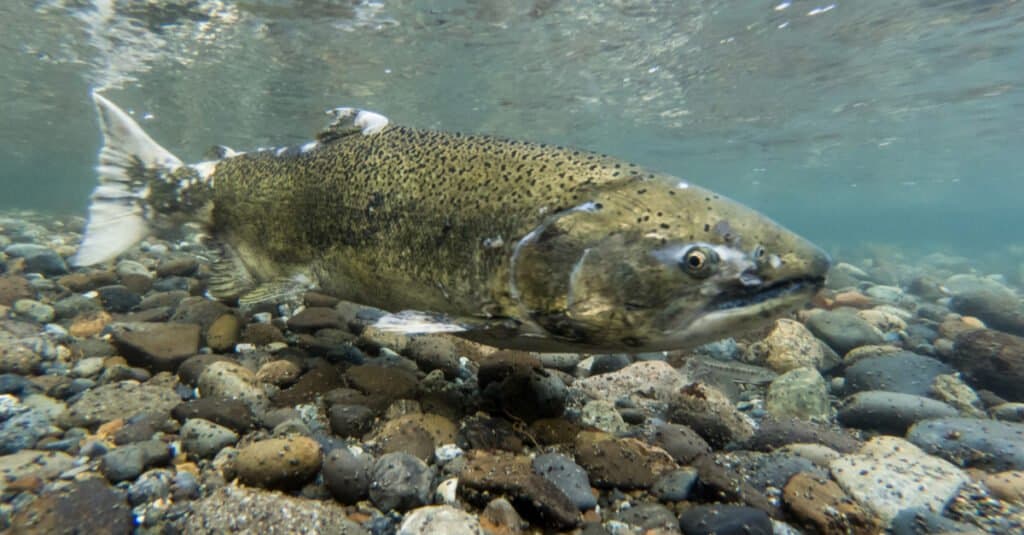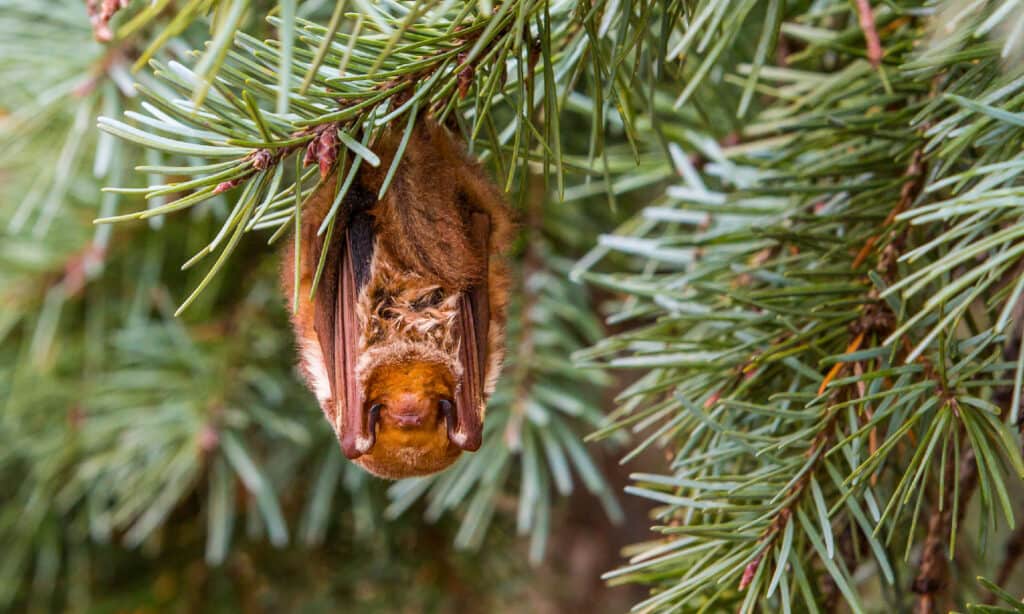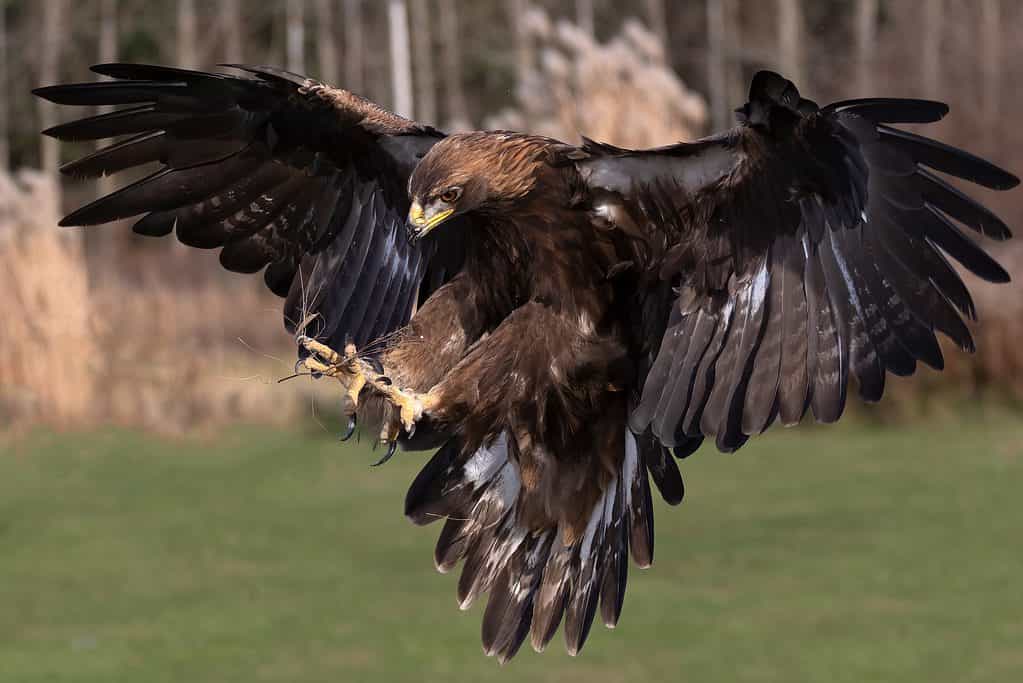Michigan is known for its frigid winters, with icy roads, snow-covered streets, and below-freezing temperatures being a familiar sight. But as climate change continues to impact our planet, weather patterns have become increasingly unpredictable. That has led to unusual fluctuations in temperature and precipitation.
In this article, we’ll explore how this past winter has compared to Michigan’s warmest ever.
Michigan’s Winter of 2022/2023

January 2023 saw Muskegon, MI, record its warmest minimum temperature on record.
©Jacob Boomsma/Shutterstock.com
Michigan’s winter of 2022/2023 had an average temperature of around 35°F, making it a top 10 warmest winter ever in the state. In December, temperatures were close to normal, with some areas in northeast Michigan experiencing slightly above-average temperatures. However, southeast Michigan experienced severe drought conditions, which continued throughout January. Despite the drought, the state experienced some precipitation, with a slight increase of 0.3 inches above normal. As a whole, the state of Michigan experienced an average temperature of 34°F in the month of December.
In January, Muskegon, MI, recorded its warmest minimum temperature on record, signaling warmer weather across the state. In fact, Muskegon’s average January temperature was 33.8°F, which is 8 degrees warmer than what is typical. The snowfall deficit continued in northern and western Michigan, particularly in lake-effected areas, which received 10-25 inches less snow than usual. Southeast Michigan saw the highest snowfall totals of 1-10 inches.
In February, Michigan had an average daytime temperature of 40 degrees and an average nighttime temperature of 32°F. But most notably in February, there was a significant winter storm in southeast Michigan. Warmer air from the Gulf of Mexico combined with a cold airmass near the surface, leading to a wintry mix of snow, sleet, and freezing rain across metro Detroit. Areas north of I-69 received higher snow accumulations, with Midland reporting 8.9 inches for the storm total.
Unfortunately, the storm brought widespread power outages and fallen trees, with DTE reporting close to 500,000 customers without power. The ice storm left many metro Detroit communities grappling with the aftermath, something that had not been seen since April 2003.
Michigan’s Warmest Winter Ever

Available data isn’t thorough enough to definitively say which Michigan winters are the warmest ever, but a few have been warmer than others.
©iStock.com/f11photo
While there have been some warm winters in Michigan, there isn’t enough data to definitively say which winter was the warmest ever. However, there have been a few winters where temperatures were significantly above average. For example, during the winter of 1881/1882, the Detroit area saw an average temperature of 36.9°F, which is much warmer than the average Detroit winter temperature of 28.
Similarly, in the winter of 1931-1932, the Flint Bishop and Saginaw areas saw temperatures of 33.4°F and 33.3°F, respectively, which were also significantly above normal.
Overall, while there have been some winters with above-average temperatures in Michigan, it’s difficult to compare them to one another and determine which was the warmest ever without more comprehensive statewide data. However, it’s clear that Michigan has experienced warm weather in the winter months at various times throughout its history.
Michigan’s Average Winter Temperatures

Winters in Michigan are quite cold and snowy on average.
©Susan B. Sheldon/Shutterstock.com
Michigan’s average winter temperatures can be described as cold to very cold. The state experiences sub-freezing temperatures from December through February and even into early March in the far northern parts of the state. The average high temperatures in some areas of Michigan are below freezing during these months.
In the Upper Peninsula of Michigan, which is located north of the Mackinac Bridge, the average winter temperatures are much colder than in the southern part of the state. The winter season in the Upper Peninsula lasts from December to March, and during this time, the average temperature ranges from 10°F to 30°F. The region receives a significant amount of snowfall during the winter season, with an average of over 200 inches of snow annually in some areas.
In the Lower Peninsula of Michigan, which is located south of the Mackinac Bridge, the average winter temperatures are slightly milder. The winter season in the Lower Peninsula lasts from December to March, and during this time, the average temperature ranges from 20°F to 35°F. The region also receives significant snowfall during the winter season, with an average of around 50-70 inches of snow annually.
The climate of Michigan’s largest city, Detroit, is milder than the rest of the state due to its location in the southeastern part of the state. The winter season in Detroit lasts from December to March, and during this time, the average temperature ranges from 23°F to 35°F. The city receives an average of around 60 inches of snow annually.
Animals That Migrate To And From Michigan
With its diverse range of habitats, including forests, wetlands, and lakes, Michigan attracts a wide variety of wildlife. Let’s take a closer look at some of the fascinating animals that migrate to and from Michigan.
Chinook Salmon

Late July through August marks the start of the prime chinook salmon season in Michigan.
©Kevin Cass/Shutterstock.com
The coloration of chinook salmon ranges from olive brown to dark brown, with the back and sides appearing almost black. Multiple spots can be observed on its back, while the fins possess only a few spots. Interestingly, both the upper and lower portions of the tail fin are adorned with spots as well. The lower gum line of this fish is black in color. The species can vary in length from 24 inches to as long as 60 inches.
This species heavily relies on alewives as its main source of food, although it also feeds on other prey such as rainbow smelt and bloaters. While it can be found throughout all the Great Lakes, Lake Michigan offers the best opportunities for fishing this fish.
Late July and August mark the beginning of the prime season for targeting the chinook salmon in Michigan. It is during this time that the salmon migrate from upper Lake Michigan to the rivers for spawning purposes.
Eastern Red Bat

While prevalent in Michigan during the summer season, eastern red bats migrate toward California and Arizona for winter.
©Elliotte Rusty Harold/Shutterstock.com
This medium-sized bat displays a remarkable “frosted” look due to its reddish coloring and white-tipped hair. This species exhibits a broad spectrum of colors, with males typically having a more vibrant red or orangish-red hue and a less frosted appearance compared to females. Females, on the other hand, tend to have a less intense coloration, ranging from dull red to chestnut. However, both males and females share a unique feature – a yellowish-white patch located in front of each shoulder.
Eastern red bat feeds primarily on moths and beetles but also consumes other insects such as leafhoppers, spittlebugs, and planthoppers. They inhabit a diverse habitat, particularly those that are situated over land and characterized by the presence of large deciduous trees. They can be found near the edges of croplands, pastures, or other openings with trees.
The eastern red bat is a migratory species that is prevalent in the eastern region of North America, including Michigan, during the summer season. In the winter, they may migrate toward southern California and Arizona.
Golden Eagle

It’s common to see golden eagles from Canada throughout the United States during the winter.
©Touched by light images/Shutterstock.com
The golden eagle boasts dark brown plumage that is accentuated with white feathers situated at the base of its tail. Additionally, the eagle’s head is adorned with striking golden feathers. The bird’s beak and talons are characterized by their pitch-black hue. For immature golden eagles, their tail boasts a broad band that is white with a black edge. Furthermore, the undersides of their wings display large white patches.
The eagle’s diet predominantly consists of both live and carrion mammals and birds. Though not frequently found in Michigan, golden eagles have been spotted in the state during winter. These birds typically thrive in open terrains such as mountains, foothills, plains, and other open areas.
As winter approaches, golden eagles residing in the Canadian provinces and northern tier and northeastern states will embark on their seasonal migration to regions with milder climates or reduced snow coverage. It’s common to spot golden eagles scattered throughout the continental United States during this period.
Tundra Swan

If you’re in Michigan during the winter, you may see tundra swans, which migrate from their Arctic grounds in the colder months.
©hay_mn97/Shutterstock.com
The plumage of tundra swans is entirely white, which provides a striking contrast to their mostly black bill. Typically, their bill features a yellow spot at the base. Additionally, their legs and feet are black, completing their sleek appearance. Younger tundra swans have a grayish hue on their wings, head, and neck. That makes them easily distinguishable from their fully mature counterparts.
The primary diet of tundra swans comprises roots, stems, and leaves of aquatic plants such as pondweeds, mannagrass, and algae. They typically forage in the water, using a dabbling or dipping method to feed by submerging their heads underwater.
Tundra swans are not typically present in Michigan during the summer months. They spend that time in their remote Arctic breeding grounds. However, they can be spotted during the winter and migration seasons, as they are known to frequent many large bodies of water in the region. These birds also tend to visit farm fields in large flocks in search of food.
The photo featured at the top of this post is © Jacob Boomsma/Shutterstock.com
Thank you for reading! Have some feedback for us? Contact the AZ Animals editorial team.






